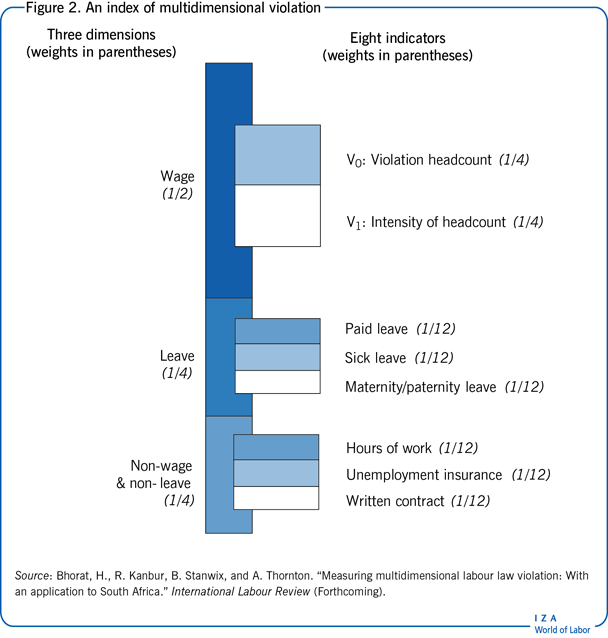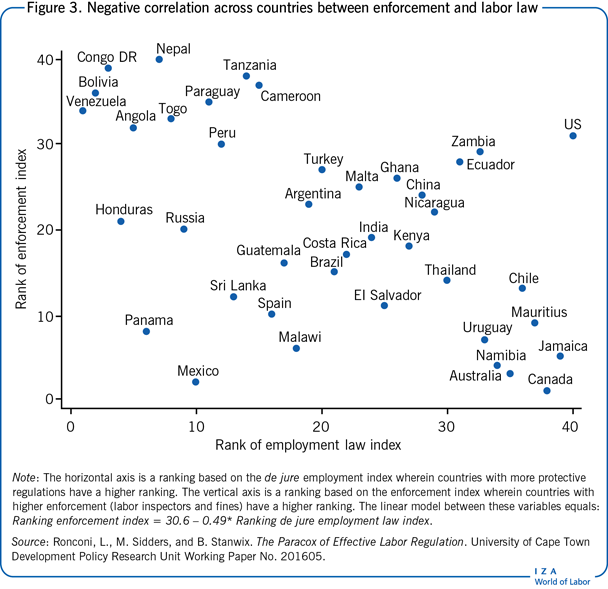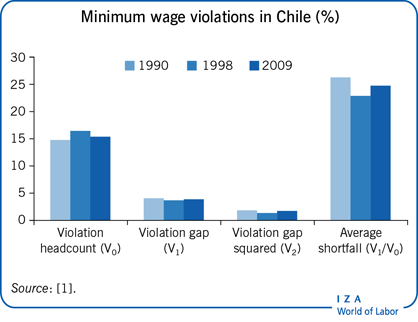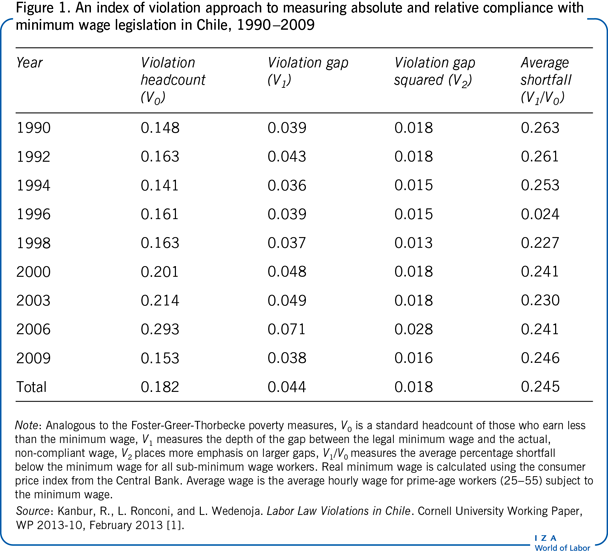Elevator pitch
Compliance with minimum wage laws and non-wage conditions of employment often depends on labor market specific factors. In developing countries, many workers still earn less than the legal minimum and lack access to mandated non-wage benefits. Enforcement has not kept up with regulation growth and compliance has not been measured from a multidimensional perspective. Such an approach would help to understand the impact of institutional variables and country-specific approaches on the level of labor law violation. The difference between de facto and de jure regulation remains particularly pertinent in countries where compliance is low.
Key findings
Pros
An index of minimum wage violation would allow decision-makers to analyze the level and depth of non-compliance and act accordingly.
Violation of non-wage labor laws in developing countries is high and often overlooked.
A multidimensional index of labor law violation is useful for providing more comprehensive data on non-compliance.
Despite limited enforcement there is evidence that employers do respond to wage regulations, although compliance remains partial.
Attention needs to be placed on de facto, rather than just de jure, labor market regulation.
Cons
If data on enforcement and compliance are scarce, finding appropriate measures for both is problematic.
Very high minimum wages and overly strict non-wage laws can lead to unemployment and other economic costs that compliance and enforcement reinforce.
A lack of skills and resources often limits enforcement practices.
Raising the number of inspectors will not necessarily raise compliance rates.
Enforcement in a severely resource-constrained environment is difficult when minimum wage and other labor regulations are complex.
Author's main message
Despite concerns about the effect of minimum wage laws and employment regulations on employment and the economy, enforcement and compliance remain critical. Resource-constrained developing countries should enforce minimum wage laws in a way that both protects employment and incentivizes firms to comply. An index of minimum wage and multidimensional labor violation can provide important data for enforcement decisions, and provide a powerful policy tool for guiding where and how to channel enforcement resources most effectively.
Motivation
While there has been a broad expansion in regulatory regimes that attempt to protect workers from exploitation, a substantial gap remains between regulatory intent and regulatory outcomes in most developing country labor markets. As a consequence, enforcement remains central to the debate over the effect of minimum wage regulations, and labor regulation more generally. A practical issue related to enforcement and compliance is one of measurement; particularly how to measure non-compliance and enforcement.
This article reviews the research on enforcement and compliance in developing countries, focusing largely on minimum wage legislation but also goes on to consider a multidimensional measure of labor law violation. Guidance is offered to help policymakers derive measures and formulate strategies to establish a more conducive environment for minimum wage enforcement and compliance.
Discussion of pros and cons
The impact of minimum wages on employment varies
Studies on the impact of minimum wages in the US were the first to suggest that the theoretical wage–employment trade-off does not always hold in practice: an increase in the minimum wage is not always synonymous with a decline in employment. Studies on developing countries have similarly shown that introducing or increasing a minimum wage can have mixed effects.
Studies find evidence of significant employment declines in some cases, but not in others. For instance, results for Brazil show that minimum wages have had no significant effect on either formal or informal employment [2]. In Vietnam, however, the minimum wage is shown to have an insignificant impact on overall employment, but a significant negative employment effect in the formal sector—as laid-off workers have sought employment in the informal sector [3]. The conclusion for Vietnam is that low-wage workers in the formal sector need protection from the negative effects of the minimum wage. Minimum wage increases in Colombia and in the agriculture sector in South Africa have also had negative employment effects [4], [5]. In South Africa, no employment declines have been found for other sectors with a minimum wage, including retail, domestic work, forestry, and security, and the taxi service sector [6].
These differences in outcomes suggest that the employment effects of a minimum wage hike are unpredictable, particularly when there is imperfect enforcement, so that both compliant and non-compliant employers are in the labor market. One study provides evidence of partial compliance in South Africa—where employers adjust wages upwards as a result of the law, but not all the way to the minimum wage [7]. Such results strongly suggest that it is important to understand employer responses to the minimum wage as occurring across a range at and below the set minimum. In most cases then, determining the impact on employment requires empirical investigation, both at the country and sectoral levels. This includes an examination of compliance levels.
Evidence on enforcement and compliance with minimum wage laws
While there is no consensus on the effect of minimum wage laws on the labor market, the literature does broadly agree that enforcement of and compliance with minimum wage laws are low in most developing countries. Formal enforcement efforts are weak, and a substantial proportion of workers still receive sub-minimum wages [8], [9].
The required legislative frameworks are in place, and many countries now have an extensive web of labor regulations, including minimum wage laws. Some regulatory frameworks are so detailed that countries have multiple minimum wages that differ across sectors, as in Costa Rica and Kenya. In South Africa, statutory minimum wages vary not only by sector, but also in some cases by occupation and location, resulting in more than 36 different minimum wages. Thus, it is not generally a lack of labor regulation that is of concern, but rather a lack of compliance with existing regulations because of imperfect enforcement [8].
Several recent empirical studies on compliance levels reveal that a large proportion of workers in developing countries earn wages below the legal minimum. For example, in Argentina, only half of the workforce receives the legally mandated minimum wage and other benefits, including restrictions on the maximum number of hours worked and compensation for work-related injuries [8]. In Kenya, non-compliance with minimum wage laws soars to nearly 70% in higher-skilled occupations in urban areas. The many categories of minimum wages in Kenya make compliance and enforcement more difficult. In South Africa, just under half of the workforce is estimated to receive wages below the legal minimum, but there is considerable variation between sectors. Other studies find similarly high levels of non-compliance in developing countries such as Brazil, Chile, and several other Latin American countries, and Trinidad and Tobago [2], [4], [9].
However, not all developing countries have such high levels of non-compliance. In Vietnam, for example, just over 3% of formal and private sector workers earned sub-minimum wages in 2006; estimates are only slightly higher for the public sector, at 4.2%, and the informal sector, at 6.8% [3].
Measuring non-compliance
Currently, non-compliance with minimum wage legislation is typically measured as the percentage of workers in a country who are paid below the appropriate minimum wage. However, this is a fairly blunt measure, as it fails to measure the extent of the underpayment. Workers earning just slightly less than the legislated minimum wage are not distinguished from workers who are paid well below the minimum, in gross violation of minimum wage legislation.
A method for measuring non-compliance that solves this problem draws on the well-known Foster-Greer-Thorbecke (FGT) poverty measurement technique to create an index of minimum wage violation [10]. Figure 1 and the Illustration show how the index can be applied to measure non-compliance in Chile.
In 2009, for example, 15.3% of workers earned less than the minimum wage. The index measures not only the percentage of workers earning below the minimum (V0, analogous to the headcount ratio in the FGT poverty measure), but also the depth of the violation (V1, or the gap between each worker's wage and the minimum wage, analogous to the poverty gap), and the severity of the violation (V2, or the depth of the violation squared, which weights people at the bottom of the distribution more heavily). Additionally, V1/V0 denotes the percentage shortfall of the average wage of underpaid workers from the minimum wage. Put differently, underpaid workers earn on average V1/V0 below the minimum wage.
The index allows researchers to analyze both the level and the depth of non-compliance. Enforcement policy is too often guided by aggregate national-level labor market data or even by outlier incidents of egregious violations of the minimum wage by employers. Policymakers need accurate and detailed labor market information. Because so many countries lack such information, this method of measurement can aid policymakers in improving compliance. The index of minimum wage violation can provide more disaggregated baseline data on which to base enforcement decisions. Such a measure can be a powerful policy tool for guiding where and how to channel enforcement resources most effectively.
Measuring multidimensional labor law violation
The minimum wage is, however, only one dimension of workers’ employment rights contained in labor law. There are many other dimensions, including maximum working hours, mandated leave, unemployment insurance, and the provision of a written contract. Compliance in each of these dimensions is an issue for effective labor regulation, but specialized studies usually only highlight violations in a single domain. Drawing on developments in the measurement of multidimensional poverty one study proposes a measure of multidimensional labor law violation that aggregates and quantifies violations across a range of measurable dimensions of labor law [11].
The measure also allows a quantification of the contribution of different dimensions to the overall measure of violation where, as in the poverty literature, selecting the weight of each dimension to the overall index is a subjective decision. This allows the index to provide useful information on the nature and granular structure of labor law compliance in a country as well as the relationship between multidimensional violation and labor market variables that may affect compliance. Figure 2 shows the basic structure of the index, which relies on compliance data along three dimensions (wages, leave, and a set of additional employment rights). Several useful statistics can be extracted from the index: a headcount, a measure of intensity of violation, and the overall multidimensional violation index score. As in the case of multidimensional poverty, the index score itself has no inherent meaning but is used for comparison across countries and over time.

Effective regulation
The low levels of enforcement and compliance in developing countries necessitate a re-thinking of the way that the impacts of labor regulations are studied and understood. Variations in labor laws around the world are often used to test the impact of regulatory regimes on a number of outcomes, such as employment. But this implicitly assumes that regulations are enforced, which is misleading, especially when applied to developing countries where there is a substantial difference between de jure and de facto labor regulation. In fact, a recent study suggests that countries with more stringent regulations tend to enforce less—suggesting that de jure regulation is a poor proxy for effective regulation [12].
In Figure 3, countries with more stringent labor codes and low levels of enforcement, such as Australia and Canada, are located in the lower right corner, while countries with protective laws and little enforcement, such as the Democratic Republic of Congo and Bolivia, are located in the upper left corner. The correlation, using either rankings or indexes, is in both cases negative and statistically significant, and remains so when the sample is restricted to developing countries. The implication is that studies of the causes and implications of labor regulation that rely on the letter of the law are likely to be biased.

Understanding how enforcement practice influences compliance is crucial for policymakers. But while several studies have measured the levels of non-compliance in various developing countries, only a few of them provide empirical evidence on the causal effects of enforcement practices on compliance.
Disentangling the interactions between enforcement and compliance
There are two likely explanations for the dearth of work exploring this causal link. First, data on enforcement and compliance are scarce, and finding appropriate measures for both enforcement and compliance is problematic [13]. Second, there is an endogeneity problem due to the potentially simultaneous relationship between enforcement and compliance, which makes any causal analysis difficult. Enforcement is likely to increase compliance, as firms are more likely to comply when the probability of their being caught is higher. At the same time, however, a government agency is likely to increase the number of inspectors or enforcement resources in response to low compliance levels. The difficulty of trying to disentangle the effect of enforcement on compliance is clear.
So far, the preferred proxy for measuring enforcement is the number of labor inspectors per country (or region), which is useful as an aggregate measure but struggles to overcome the problem of endogeneity. Doing that requires the use of appropriate instruments.
Factors that influence enforcement
The recent literature on minimum wage enforcement has focused on determining which factors influence compliance (or non-compliance) in developing countries, and can thus be used to guide enforcement. This approach can be loosely designated the “determinants of non-compliance” approach. Several insights have emerged from studies that take this approach.
A study on Argentina is one of the first attempts to empirically estimate the effect of government enforcement on compliance in a developing country [8]. The study uses the number of labor inspectors working in provincial public enforcement agencies as a proxy for enforcement activity and finds that the intensity of enforcement is a significant determinant of adherence to the law. A higher concentration of inspectors is correlated with increased fines for non-compliance and suggests that this is one channel through which enforcement effectively influences compliance [8].
Another study in South Africa also uses the number of labor inspectors as a measure of the intensity of enforcement [14]. However, it finds an insignificant impact of the number of labor inspectors on compliance; the level at which the minimum wage was set had more marked effects. Despite this, in both the Argentinian and the South African studies, local labor market characteristics, most notably the unemployment rate, have a significant impact on enforcement: a higher unemployment rate is associated with lower levels of compliance.
A cross-country study presents a series of stylized facts on the incidence of enforcement. In addition to labor market characteristics, other factors such as firm size, the skill level of the workforce, and the degree of market power can all influence a firm's likelihood of being inspected and, as a result, the firm's incentive to comply with minimum wage regulations [15]. A program to increase compliance with minimum wages in Costa Rica increased average wages and compliance levels—with no significantly negative impact on employment [9]. In a sample of cities in Brazil, increased enforcement raised the level of formal employment, reduced self-employment levels, and reduced wage inequality. When stringently applied, other labor market regulations, such as those regulating firing, reduced average employment.
Factors that influence compliance
This strand of the literature suggests that there are four composite sets of variables that are important inputs for understanding the factors that shape and influence minimum wage outputs in developing countries: (i) institutional factors; (ii) characteristics of inspectors; (iii) firm characteristics; and (iv) local labor market characteristics. A template based on these inputs and outputs can help policymakers derive measures and formulate strategies to ensure an optimal environment for minimum wage enforcement and compliance.
Institutional factors include the penalty structure for failing to comply with minimum wage regulations, the number of minimum wages, the resources allocated to enforcement, and the conduct of awareness campaigns. All play a role in shaping the levels of non-compliance with minimum wage legislation, but their importance varies with the country and labor market context.
The individual characteristics of inspectors can influence how effective they are at achieving compliance. These individual characteristics include education, experience, and gender.
Firm characteristics affect the observed levels of enforcement and non-compliance with minimum wage legislation in an economy. Important characteristics include the size of the firm, the distance from the enforcement agency, the number of previous violations, and foreign ownership share.
Finally, local labor market characteristics, such as the unemployment rate, the average wage rate relative to the minimum wage, and the levels of unionization, also play a crucial role.
Considerable work remains to be done to better understand these four sets of variables. Improved descriptive and econometric work is needed to generate a comprehensive set of stylized facts to explain the factors that influence firms’ compliance decisions, and to understand their comparative importance. After that, the challenge is to gather these variables into a production function approach that estimates their effect on non-compliance levels within an economy.
Limitations and gaps
The literature implicitly assumes that minimum wage laws are adequately or perfectly enforced when that is clearly not the case, especially in developing countries. Both the data and the research in this area are at a very early stage. Evidence is scant, and data are not always available.
Very little is known about the factors that lead to violations of the minimum wage. While the literature on the effects of the minimum wage is fairly mature, researchers are just beginning to understand the levels of enforcement, how to measure enforcement, and the ultimate determinants of enforcement. Consider the practical issue of how to measure enforcement and compliance; in particular how to calculate non-compliance rates. In general, non-compliance is measured simply as the percentage of workers in a country who are paid below the applicable minimum wage. This is a fairly blunt measure, which remains silent on the extent of the underpayment.
Several studies have measured the levels of non-compliance in various developing countries, but only a small number of these provide empirical evidence on the causal effect that existing enforcement efforts have on compliance. The question of how enforcement efforts influence compliance is crucial for policymakers, but as explained above there are constraints that make it difficult to isolate the key causal relationships. This is largely due to a lack of available data on enforcement and compliance, the absence of suitable measures for each, and the endogeneity problems inherent in the enforcement–compliance interaction. In the absence of better data the preferred proxy for measuring enforcement is the number of labor inspectors and a convenient measure of non-compliance has been devised by adapting the FGT class of poverty measures to create an index of minimum wage violation. However, in order to solve the endogeneity problem the use of an instrumental variable approach or experimental design is the logical progression and this has not yet been done.
Summary and policy advice
The new index of violation is a potentially powerful policy tool. It can be used to guide where to channel enforcement resources and to conduct subsequent work on compliance, as it allows researchers to analyze the level and depth of non-compliance. This method of measurement could also aid policymakers in the large number of countries where such information remains unknown.
In the same way, a multidimensional approach to measuring non-compliance with wage and non-wage labor regulations offers a more comprehensive view and provides an index that can be used to compare compliance across countries and over time. Understanding new measurement approaches and early evidence on the determinants of enforcement can enrich the engagement between enforcement officials and researchers in developing country labor markets.
Institutional, individual, firm, and local labor market characteristics constitute an important composite set of dependent variables, critical as inputs for understanding the output of minimum wage violations and for explaining non-compliance with the law.
Several policy approaches to enforcement are possible, with the selection depending on local circumstances.
Acknowledgments
The authors thank an anonymous referee and the IZA World of Labor editors for many helpful suggestions on earlier drafts. Further support from participants at the IZA World of Labor Minimum Wage Workshop in Frankfurt, June 4, 2013 (in particular, Pierre Cahuc, Gary Fields, Tim Gindling, Alexander Kritikos, and David Margolis) is gratefully acknowledged. The article is based in part on Bhorat, H., and B. Stanwix. Minimum Wage Enforcement in the Developing World. Development Policy Research Unit Policy Brief PB 13/29, May 2013. Version 2 of the article updates the “Pros,” discusses the measurement of multidimensional labor law violation and effective regulation and enforcement, and adds new “Key references” [7], [12], [13].
Competing interests
The IZA World of Labor project is committed to the IZA Code of Conduct. The author declares to have observed the principles outlined in the code.
© Haroon Bhorat, Ravi Kanbur, and Benjamin Stanwix
The Foster-Greer-Thorbecke (FGT) poverty measurement technique
The FGT formula is defined as the sum of the difference between the poverty line, z, and individual incomes, yi, in relation to the poverty line to the power of alpha, which is a sensitivity parameter. This sum covers all people defined as poor (i.e. those with incomes at or below the poverty line) and is weighted by 1 over the total population, N.
The headcount index is the proportion of the population that is poor, and is obtained by setting the sensitivity parameter alpha equal to 1. The poverty gap measures the average distance that a poor person is from the poverty line and indicates the depth of poverty among the poor.
The FGT formula is adapted to derive a measure of minimum wage violation, where the poverty line, z, is replaced with the relevant minimum wage; the individual income, yi, represents individual wage levels for workers below the minimum wage; and alpha is a violation aversion parameter.
The proportion of individuals below the minimum wage is derived by setting alpha equal to 0. The violation gap measure is derived by setting alpha equal to 1 and denotes the average normalized gap between the wage levels and the minimum. The “squared violation gap” is derived by setting alpha equal to 2.
The focus of policy responses depends on which measure of non-compliance is used.Source: Foster, J., J. Greer, and E. Thorbecke. “A class of decomposable poverty measures.” Econometrica 52:3 (1984): 761–765.

